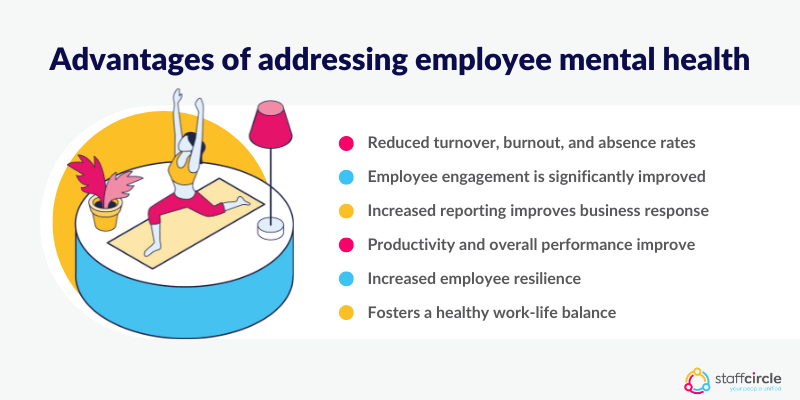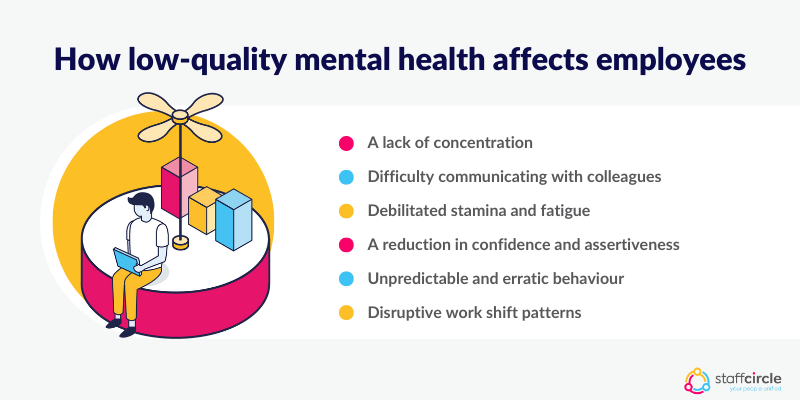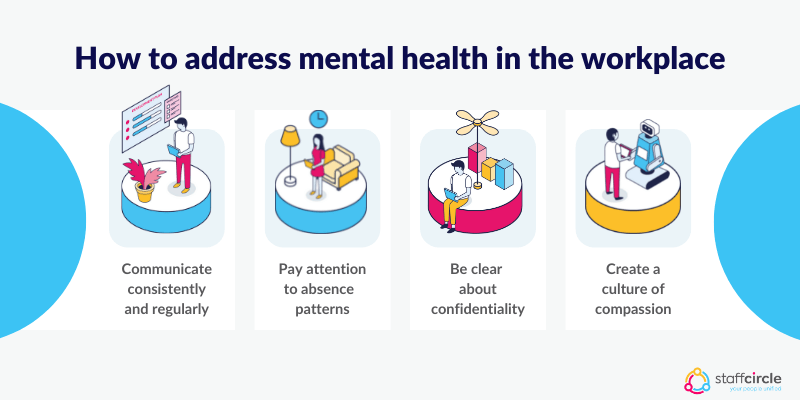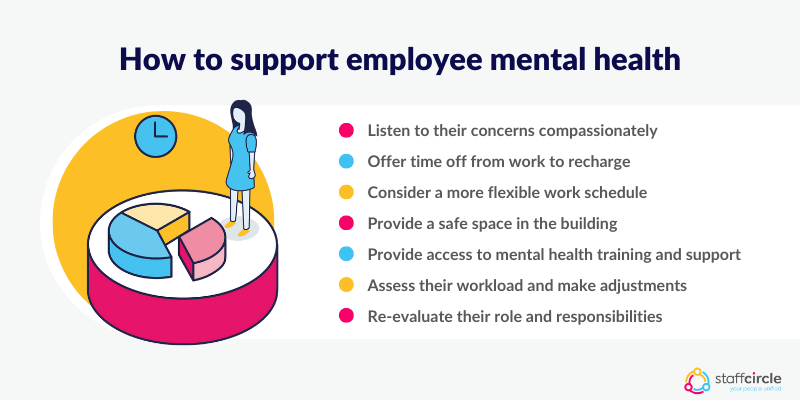Addressing mental health in the workplace has become a top priority for companies of all sizes across the globe. But identifying mental health issues before they cause irreparable damage can be challenging, with many factors to consider.
This guide will outline the early signs of mental ill health and well-being, as well as the multiple options available to support staff living with mental health concerns and their return to the workplace with confidence.
Why promoting positive mental health in the workplace is important
The COVID-19 pandemic increased levels of poor mental health and well-being, with higher levels of stress and anxiety across noted all industries. These issues are perpetuating to this day, with some studies indicating workplace mental health problems could be the most pressing of all concerns for businesses.

The article from Gallup, The Next Global Pandemic: Mental Health, sums up the negative impact poor well-being can have on businesses of all sizes.
“Anxiety and depression can destroy ideas, energy and eventually the economy — and especially small businesses, where almost 50% of us are employed. Yet these aren’t taken as seriously as physical wellbeing because we understand physical problems so much better than mental problems.”
The impact of poor well-being and mental health is also financial. A March 2022 report from the London School of Economics found that the UK economy loses at least £118 billion each year due to mental health problems. Loss of productivity, time off for treatment, and other costs all factor in and create a case for investment in preventive measures.
Beyond the monetary costs accrued through failing to deal with mental health in the workplace, there is a fundamental ethical aspect to consider. Irrespective of the financial impact, taking the time to ensure employees’ positive mental health is taken care of is the right thing to do as part of a company’s corporate responsibilities.
Let’s examine in more detail some of the reasons why supporting mental health should be a top priority for companies, and how it can affect employers and employees alike.
We’ll also cover some of the most common causes of poor mental health issues in the workplace, and what business leaders and HR managers can do to help offer support to those who need it the most.
Why should companies worry about workplace mental health?
With an increasing number of people suffering from mental health problems and low well-being, it’s more important than ever for companies to take appropriate steps to address the issue.
As we’ve seen, the cost of doing nothing is high, both in terms of financial costs for the operations of the company, and physical and emotional costs to those who are suffering from mental health issues.

There are a number of advantages when well-being and mental health is properly addressed by companies. These include:
- Reduced turnover, burnout, and absence rates
- Employee engagement is significantly improved
- Reporting of stress and challenges increases, helping businesses to better address any mental health issues
- Productivity and overall performance standards improve
- Employee resilience increases, making them more capable of dealing with stressful situations
- Fostering a healthy work-life balance to give employees the mental space needed to deliver their best performance
Addressing mental health issues in the workplace confers advantages for everyone involved. Employees with positive mental health are more motivated and driven to deliver strong performance, which leads to better outcomes for business goals in both the short and long term.
How mental health issues could affect how you work
Mental health issues can affect workplace performance in a variety of ways. This affects the employer and employee in different ways, which we’ll take a look at in more detail now.
As an employer
When members of the workforce experience poor mental health, the employers suffer as well as the employee. As we’ve touched on earlier, this can result in drops in productivity that result in the company facing financial losses. Targets aren’t met, members of staff take more time off sick, and the quality of work drops.

As an employee
Low mental health affects employees in more profound ways than it does the employer, and in the worst-case scenario can lead to severe physical discomfort and even cause employees to leave the company permanently.
Some other ways low-quality mental health can affect employees include:
- A lack of concentration
- Difficulty effectively communicating with colleagues
- Debilitated stamina and fatigue
- A reduction in confidence and assertiveness
- Unpredictable and erratic behaviour
- Disruptive work shift patterns that impact the employee’s team or department
What are the most common mental health issues in the workplace?
Understanding the most common types of mental health issues in the workplace equips managers and HR leaders with the knowledge to intervene early.
Let’s take a look at three of the most common mental health types in more detail.
Depression
Depression is one of the most common mental health issues facing employees today. It can result in much higher levels of absenteeism, with those who suffer from depression feeling restless, deflated, and consistently fatigued.
Employees living with depression may try to hide their symptoms, making it more difficult for employers to intervene with support and solutions. If an employee’s productivity is declining and they are reporting feeling aimless, depression could be a possible root cause.
Stress
Workplace stress can be caused by a wide range of factors, many of which companies can take action to counteract. Working long hours, performing repetitive tasks, and conflicts with bosses and colleagues can all contribute to feelings of stress.
Stress can manifest itself in a drop in productivity and overall performance, and managers and team leaders can identify this early on through regular one2one check-ins with staff, where they can ask about their well-being.
Anxiety
Depression and anxiety are mental health issues that can each result in lower productivity, morale, nervousness, and irritability. Mood fluctuations and a short temper are also indications that an employee could be experiencing anxiety which should be addressed with a view to offering support.
How do you deal with mental health in the workplace?
While mental health issues are of increasing concern for many organisations, fortunately, there are systems and methods that can be used to help deal with the problem.
1. Communicate consistently and regularly with employees
One of the main reasons why mental health issues become a problem is because they go unnoticed for long periods of time. When employers don’t communicate about well-being, staff who are experiencing mental health difficulties may bottle up their problems. When this happens, mental health concerns can compound over time until they reach boiling point.
Business leaders and HR departments can improve their mental health and wellbeing strategies by implementing consistent employee feedback mechanisms in the workplace. By carrying out regular conversations with their team, managers and team leaders can place mental health front and centre to address problems early on.

2. Pay attention to absence and sickness patterns
Frequent and unplanned absences are a surefire indication that an employee may be experiencing mental health concerns. When employees take regular days off sick without any physical ailments to deal with, there’s a good chance their mental well-being is suffering.
HR professionals can monitor absence and sickness patterns with HR software, flagging employees who appear to be taking more time off than usual. When this happens, the employee’s direct report can schedule a meeting to discuss the issue and see what the company can do to help them address their workload and any other factors of concern.
3. Be clear about confidentiality
Another reason why employees who are experiencing low levels of mental health might refrain from speaking up is the fear that their issues will not be handled with discretion.
Businesses can reassure staff that any problems they are having will be dealt with confidentially through the employee handbook and other internal company documentation.
4. Create a culture of compassion
A company culture that embraces compassion and sensitivity is more likely to foster a healthy work environment. Business leaders can place well-being in the foreground of their cultural values, so staff understands that they are encouraged to come forward and speak to their manager if their mental health is suffering.
This can also include managers and team leaders modeling this approach to culture. If employees see their superiors are willing to be open about their emotional and physical well-being, they will speak up with confidence if they face problems of their own.
How can employers support people living with mental health conditions?
If you become aware that one of your employees is experiencing mental health concerns, there are several courses of action you can take.

The recommendations below cover most instances, but every employee and situation is different. It’s important to tailor your response in the most appropriate way to provide effective support.
- Sit down in a private space and listen to their concerns compassionately
- Offer the employee time off from work to recharge
- Consider a more flexible work schedule so they can address any work-life balance issues they may be experiencing
- Provide a safe space in the building where they can take some time out from the bustle of office activity
- Provide access to mental health training and support, such as counseling through the occupational health nurse or another professional service
- Assess their workload and see if any adjustments can be made to ease some pressure
- Re-evaluate their role and responsibilities and see if there is an alternative that is better suited to their skills and temperament
In Summary
Mental illness, low physical health, and neglected mental well-being not only take a toll on the company’s business outcomes but can also seriously impact the overall health of those who experience these problems.
By using this guide, HR leaders and managers can identify the tell-tale signs of poor mental health before they become overwhelming. They can also step in and offer a range of remedies to help employees overcome these challenges and return to a healthy and productive role within the company.





